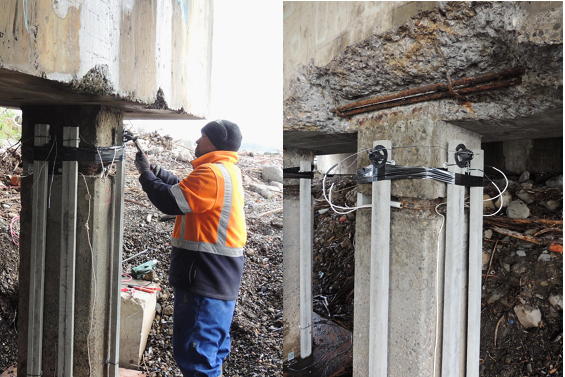
27 Sep 2015 Port Road Bridge, Wellington

Date: June – Sep 2015
Client: Hutt City Council
Consultant: GHD
Contractor: BBR Contech
Port Road Bridge forms a part of the Hutt City Council roading network. The bridge is thought to be over 50 years in age, and runs over the Waiwhetu stream adjacent to the Wellington Harbour.
The bridge is a combination of cast in-situ and precast concrete, supported by pre-stressed piles. Previous routine inspection of this bridge indicated that this bridge showed signs of corrosion occurring. The project Specification as prepared by GHD proposed remediation measures including the installation of sacrificial anodes and protective pile jackets to extend the service life of the bridge structure by a further 50 years. The work scope included:
Bridge Piers:
- Installation of Galvanode DAS Marine anodes to RC piles
- Installation of ‘bracelet’ bulk zinc anodes to these piles
- Installation of FRP jackets
- Grouting of the jackets to encapsulate and provide permanent protection of the DAS anodes
- Make good steel continuity to piles as necessary
- Installation of system monitoring facility (including reference monitoring electrodes, wiring, terminals and junction boxes) at two pile locations.
Bridge Beams:
-
- Removal and reinstatement of loose and delaminated concrete (approx. 6m2 area)
- Installation of sacrificial Galvashield XP2 anodes to beam repair locations.
Refurbishment of the 18 piles included installing the Galvanode DAS Marine anodes (as supplied by Concrete Plus). The anode layout configuration was confirmed by the Engineer and anode supplier prior to installation. Anodes were connected to the reinforcement of the piles, which was checked for continuity and made good as necessary.
A comprehensive QA plan was produced to ensure all elements of the remedial work, CP installation and commissioning were undertaken in accordance with the Specification and relevant sections of the Standard for CP installation for concrete structures (AS 2832.5).
Additional wiring and connections were required at the two monitored piles. This enabled for installation of terminals (located inside junction boxes) to allow for future checks to be made of the system. Commissioning tests and records showed very pleasing results with significant change in potential and current flow achieved as the CP circuits were created by connection of the anodes to the pile reinforcement.

